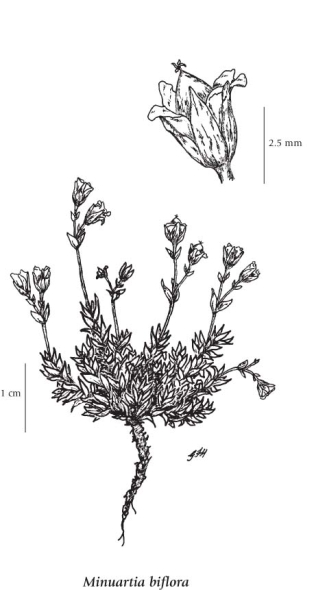Cherleria biflora (L.) Schinz & Thell.
mountain sandwort
Caryophyllaceae (Pink family)
Introduction to Vascular Plants
mountain sandwort
Caryophyllaceae (Pink family)
Introduction to Vascular Plants
Species Information
General:
Perennial herb from a taproot and branching stem-base; forming mats up to 15 cm across; flowering stems erect, simple to few branched, glandular, 2-5 cm tall.
Leaves:
Basal leaves linear, 2-10 mm long, less than 1 mm wide, 1-nerved, glabrous to slightly hairy; stem leaves opposite, 2-3 pairs, linear, 2-8 mm long; stipules lacking.
Flowers:
Inflorescence of solitary or paired flowers; petals 5, white, narrowly oblong, 2-4.5 mm long; sepals 5, linear-oblong, rounded to obtuse and sometimes purplish at the tips, prominently 3-nerved, 2-4 mm long.
Fruits:
Capsules cylindric, 2.5-5 mm long, 3-valved; seeds 0.6-0.8 mm long, reddish-brown, smooth to minutely roughened.
Illustration

If more than one illustration is available for a species (e.g., separate illustrations were provided for two subspecies) then links to the separate images will be provided below. Note that individual subspecies or varietal illustrations are not always available.
Illustration Source: The Illustrated Flora of British Columbia
Ecology
Ecological Framework for Cherleria biflora
The table below shows the species-specific information calculated from
original data (BEC database) provided by the BC Ministry of Forests and Range.
(Updated August, 2013)
The table below shows the species-specific information calculated from
original data (BEC database) provided by the BC Ministry of Forests and Range.
(Updated August, 2013)
| Site Information |
Value / Class |
||
|
Avg |
Min |
Max |
|
| Elevation
(metres) |
2067 | 1510 | 2490 |
| Slope
Gradient (%) |
17 | 7 | 45 |
|
Aspect (degrees) |
222 | 80 | 345 |
| Soil
Moisture Regime (SMR) [0 - very xeric; 4 - mesic; 8 - hydric] |
3 | 0 | 4 |
| Modal
Nutrient Regime
Class |
C | ||
| #
of field plots species was recorded in: |
9 | ||
| Modal
BEC Zone Class |
IMA | ||
|
All BEC Zones (# of stations/zone) species was recorded in |
AT(1), BAFA(2), ESSF(2), IMA(4) | ||
|
Source:
Klinkenberg 2013
|
|||
Habitat and Range
Dry, calcareous gravelly to rocky slopes in the alpine zone; infrequent in N and SE BC; N to AK, YT and NT and E to PQ.Status Information
Synonyms
Synonyms and Alternate Names:
Minuartia biflora (L.) Schinz & Thell.